PR
X
Keyword Search
▼キーワード検索
Comments
私はイスラム教徒です@ Re:アイルランド・ロンドンへの旅(その131): ロンドン散策記・アルバート記念碑(Albert Memorial)-2(11/06)
神神は言った: コーランで 『 (21) 人々…
私はイスラム教徒です@ Re:アイルランド・ロンドンへの旅(その122): ロンドン散策記・Victoria and Albert Museum・ヴィクトリア&アルバート博物館-5(10/28)
神神は言った: コーランで 『 (21) 人…
【甥のステント挿入…
 New!
Gママさん
New!
Gママさん
2025年版・岡山大学… New!
隠居人はせじぃさん
New!
隠居人はせじぃさん
続日本100名城東北の… New! オジン0523さん
ムベの実を開くコツ… noahnoahnoahさん
noahnoahnoahさん
エコハウスにようこそ ecologicianさん
 New!
Gママさん
New!
Gママさん2025年版・岡山大学…
 New!
隠居人はせじぃさん
New!
隠居人はせじぃさん続日本100名城東北の… New! オジン0523さん
ムベの実を開くコツ…
 noahnoahnoahさん
noahnoahnoahさんエコハウスにようこそ ecologicianさん
Calendar
カテゴリ: 海外旅行
【 海外旅行 ブログリスト
】👈️リンク
セントポール大聖堂の裏の東側、チェーニー・レーン(Cheyne Lane)沿いの路面に
八角形の石畳の囲みの中に「 HERE STOOD PAUL’S CROSS 」と。
セントポール大聖堂の裏の東側、チェーニー・レーン(Cheyne Lane)沿いの路面に
八角形の石畳の囲みの中に「 HERE STOOD PAUL’S CROSS 」と。
・ポールズ・クロス (Paul’s Cross) は、セント・ポール大聖堂の敷地北東角に設けられていた
屋外説教壇 。
屋外説教壇 。
・13世紀頃から設置され、 ロンドン市民の前での説教や布告、政治的・宗教的演説の場
として知られた。
として知られた。
・宗教改革期には、王権の政策や宗教的論争を市民に直接伝えるための重要な舞台となり
しばしば群衆を集めた。
しばしば群衆を集めた。
・ 1643年、ピューリタン革命の混乱の中で破壊
され、その後は再建されなかった と。
現在の大聖堂(クリストファー・レン設計)が完成した後も、市民の記憶に残る歴史の象徴
として、この場所を示す石畳が設置された。
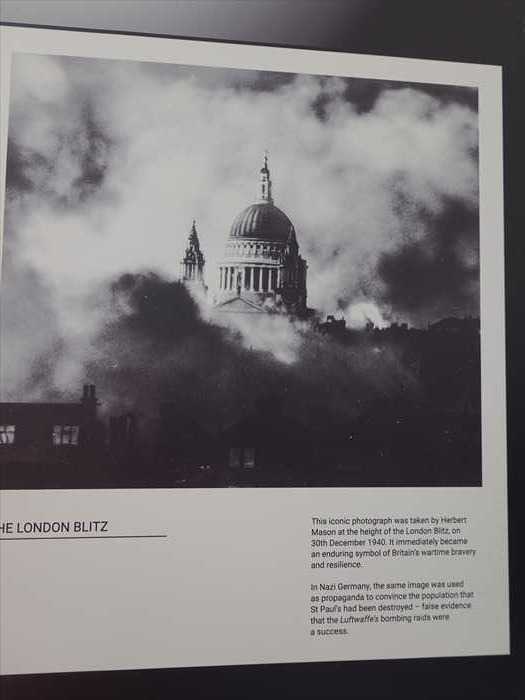
このパネルは「 THE LONDON BLITZ IN NUMBERS(数字で見るロンドン大空襲) 」 を
テーマとする統計的な展示解説。
「 THE LONDON BLITZ IN NUMBERS
軽量の焼夷弾は広く使用され、隣接する建物へと火災を拡大させた。さらに、地雷や大型の
高性能爆弾が投下され、被害を最大化した。
「 DANGER AND DAMAGE(危険と被害) 」
大聖堂が戦時中に直面した被害をテーマにした展示 。
・背景写真
・パネルの背景には、爆撃後の修復作業か、建物内部の補強工事の様子と思われる白黒写真
が使用されていた。
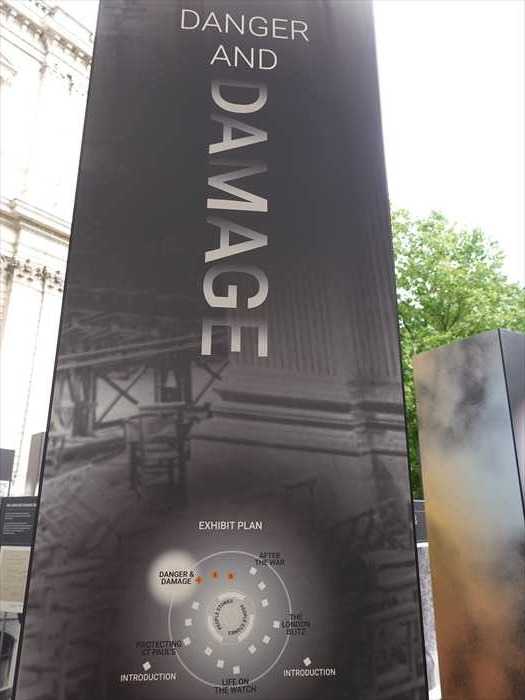
「‘None of us will, I imagine, forget the dull roar of those tons of falling masonry
followed by the rasping sound of falling glass which seemed to continue for
many minutes.’
Watch Commander Godfrey Allen, recalling the night of 16th April 1941」
【「我々の誰一人として忘れることはないだろう。何トンもの石材が崩れ落ちる鈍い轟音、
その後に続いたガラスが砕け散る鋭い音――それは何分もの間、鳴り響き続けていた。」
見張り隊指揮官 ゴドフリー・アレン、1941年4月16日の夜を回想して】
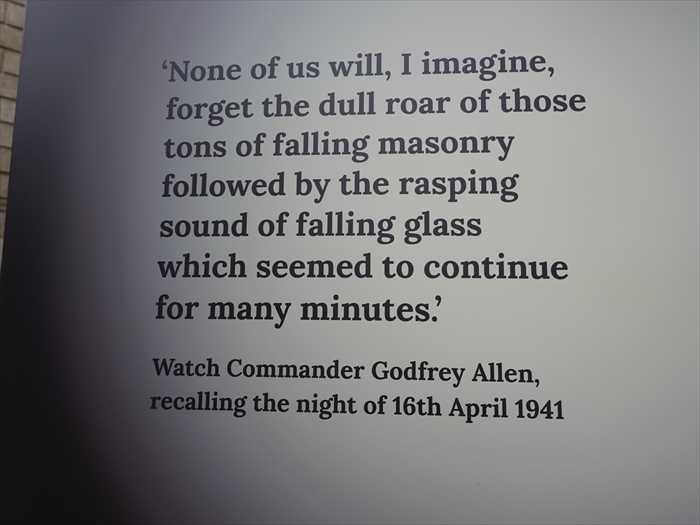
「 RECRUITMENT AND EXPANSION
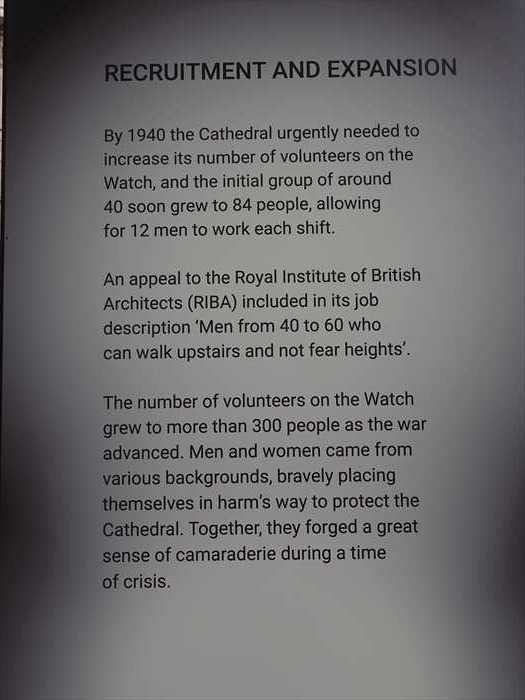
「 A DIRECT HIT
The cherubs pose as if they are raising their arms over their heads for protection.」
【 危険と被害
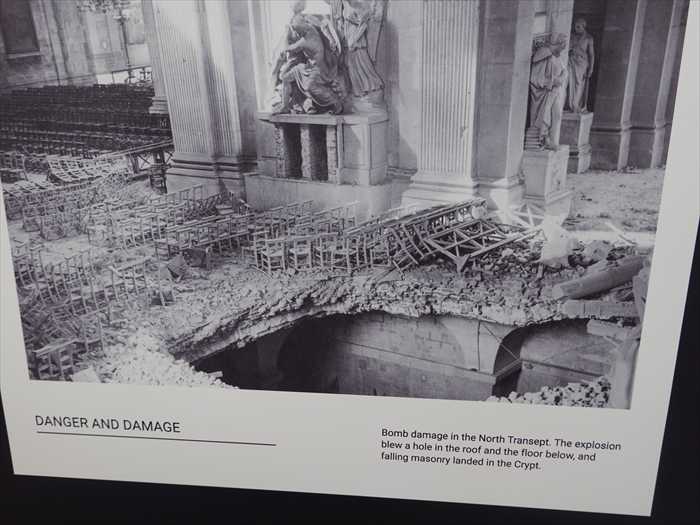
「 SECONDS FROM DISASTER
現在の大聖堂(クリストファー・レン設計)が完成した後も、市民の記憶に残る歴史の象徴
として、この場所を示す石畳が設置された。
八角形は「説教壇の基壇の形」をイメージしており、訪れる人々に「ここがかつてロンドンの
声が響いた場所」であることを思い起こさせるのであった。

PAUL’S CROSS をネットから。
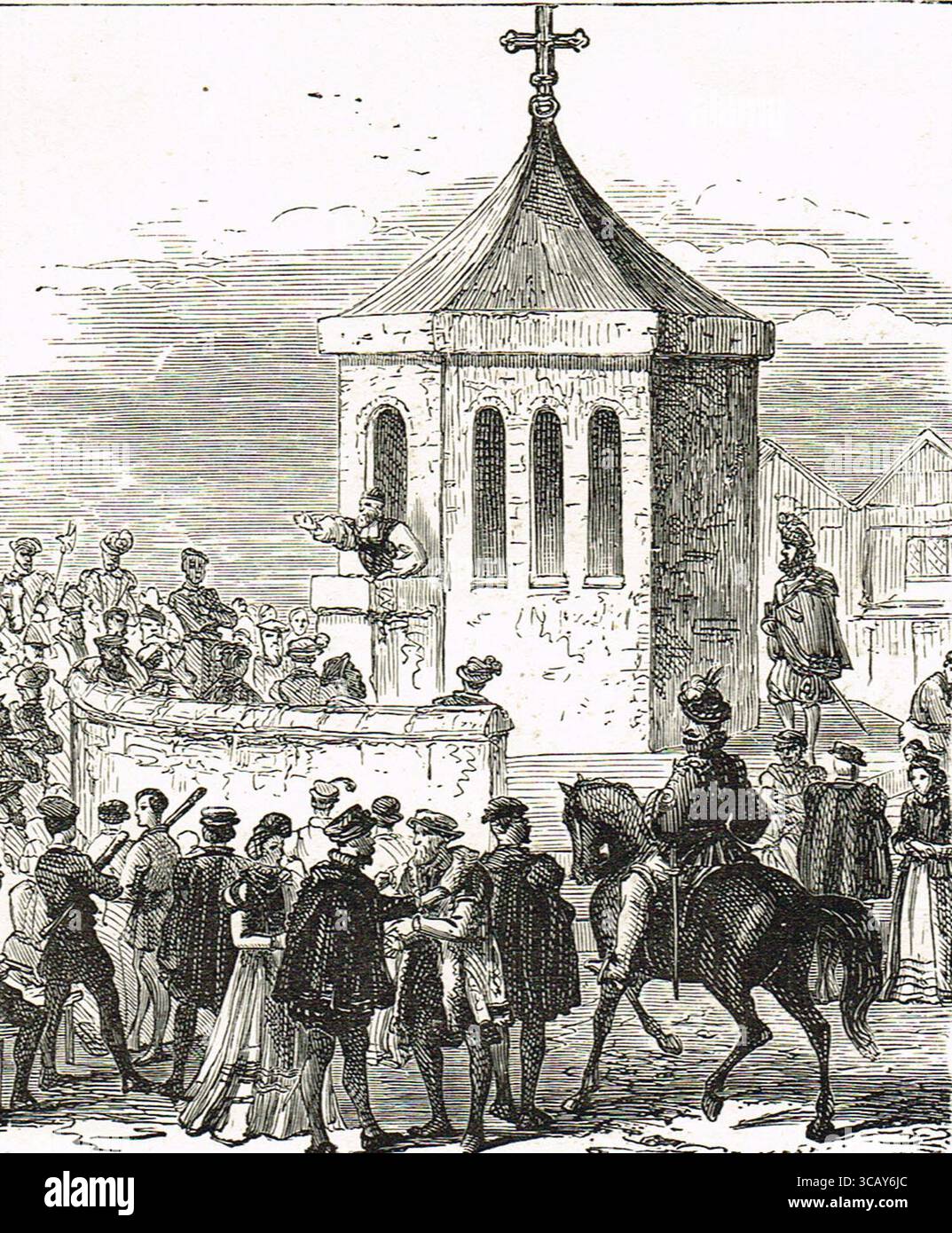
その近くから、 St Paul's Cathedral School(セント・ポール大聖堂付属学校) の校舎に
付属している尖塔 を。
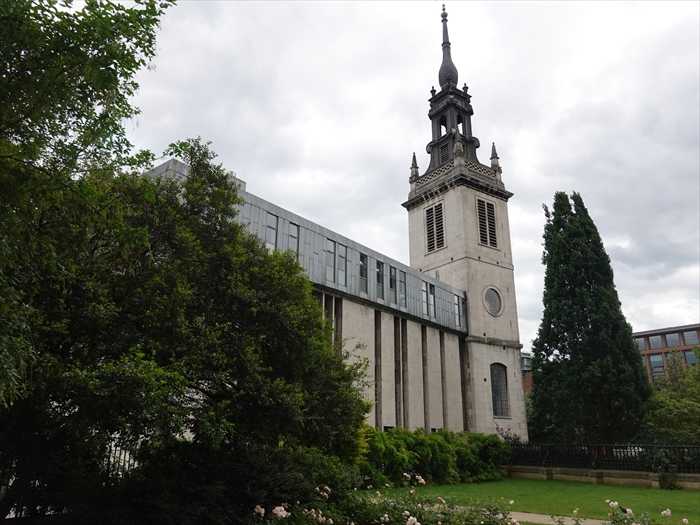
元 St Augustine, Watling Street 教会の鐘楼・尖塔。
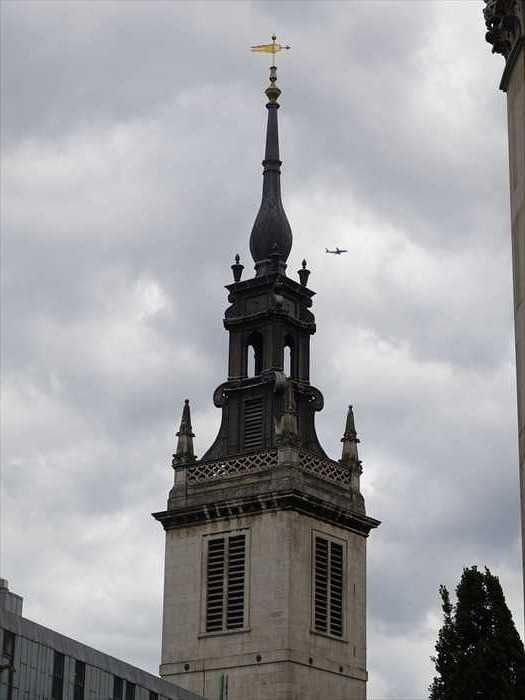
ベインブリッジ・コプナル(Bainbridge Copnall, 1903–1973)作『Becket』 。
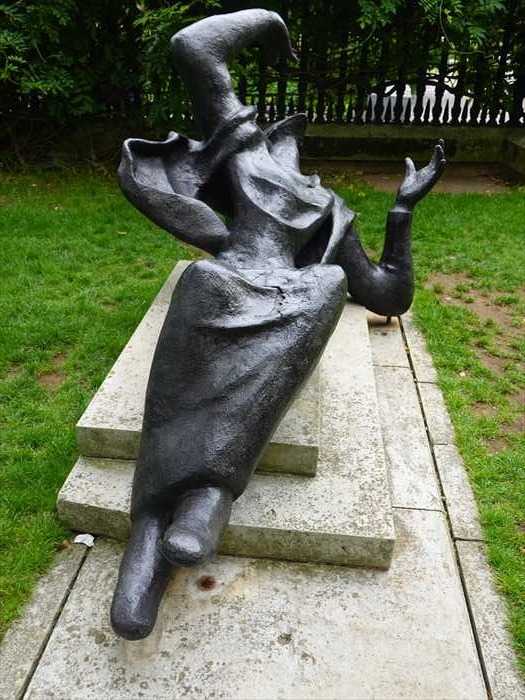
「 BECKET
【 ベケット
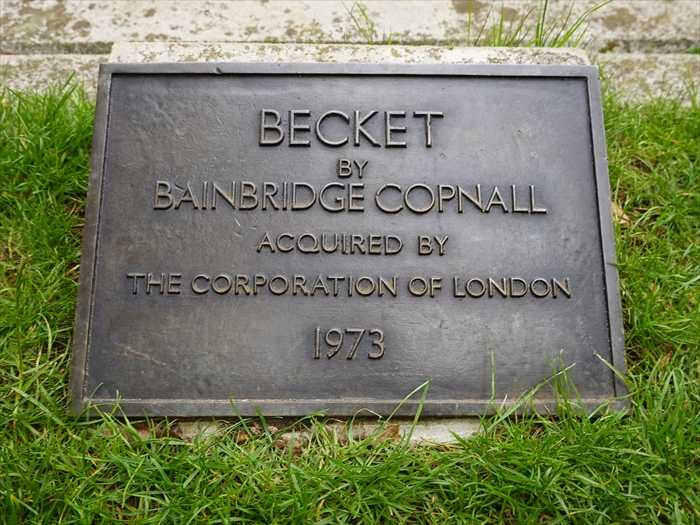
・黒いブロンズ製で、躍動的にねじれた人体像。

顔をクローズアップして。

声が響いた場所」であることを思い起こさせるのであった。

PAUL’S CROSS をネットから。

その近くから、 St Paul's Cathedral School(セント・ポール大聖堂付属学校) の校舎に
付属している尖塔 を。

元 St Augustine, Watling Street 教会の鐘楼・尖塔。
・場所:
セント・ポール大聖堂のすぐ北側、フォスター・レーン(Foster Lane)沿い。
・設計者:
クリストファー・レン卿。
・第二次世界大戦のロンドン大空襲(Blitz)で教会本体が破壊され、塔だけが残された。
・戦後、廃墟となった教会跡は撤去され、残った塔がランドマークとして保存された。
・ その周辺に St Paul’s Cathedral School の新校舎が建てられ、現在は校舎と塔が一体化して
見える形になっているのだ と。
・尖塔の特徴:
・第二次世界大戦のロンドン大空襲(Blitz)で教会本体が破壊され、塔だけが残された。
・戦後、廃墟となった教会跡は撤去され、残った塔がランドマークとして保存された。
・ その周辺に St Paul’s Cathedral School の新校舎が建てられ、現在は校舎と塔が一体化して
見える形になっているのだ と。
・独特の「洋梨型(ルイ15世風)」の尖塔を持ち、レンの設計の中でも珍しい造形。
・ 三層構造で、下部は四角塔、中段は八角、上段はバロック的な曲線をもつ尖塔
。
・ 先端には風見鶏
が立つ。

ベインブリッジ・コプナル(Bainbridge Copnall, 1903–1973)作『Becket』 。
・『Becket』は、カンタベリー大司教トマス・ベケットの殉教を表現した作品。
・トマス・ベケットは1170年にカンタベリー大聖堂で暗殺され、信仰と権威の象徴的存在と
なった。
なった。
・この像は1973年にロンドン市によって取得され、セント・ポール大聖堂北側の庭園に
設置されていた。
設置されていた。

「 BECKET
BY
BAINBRIDGE COPNALL
ACQUIRED BY
THE CORPORATION OF LONDON
1973」 【 ベケット
作者:ベインブリッジ・コプナル
ロンドン市によって取得
1973年】
・黒いブロンズ製で、躍動的にねじれた人体像。
・手足は大きく表現され、特に手のポーズが劇的。
・頭部は後方へ反り返り、殉教の苦悶や力強さを表している。
・彫刻は抽象的・表現主義的で、リアルな細部よりも「感情や瞬間の迫力」が強調されて。

顔をクローズアップして。
・頭部が大きく後ろに仰け反り、顔の造形は抽象化されながらも「苦悶」「叫び」の表情を
感じさせる。
感じさせる。
・口元は深い切り込みで表現され、声を発しているかのように見える。
・左手は大きく掲げられ、手のひらを開く仕草は「抵抗」「訴え」「神への祈り」のいずれも
連想させる。
連想させる。
・表現主義的な強調によって、殉教の瞬間の痛みと精神性がダイレクトに伝わって来る。
この姿は、1170年にカンタベリー大聖堂で暗殺されたトマス・ベケット大司教が殉教する
瞬間を表しており、
・顔の歪み=苦しみと同時に信仰を貫く決意
・開かれた手=「神に委ねる」「無抵抗の殉教」 を象徴的に表していると考えられる と。

この胸像は ジョン・ダン(John Donne, 1572–1631) を表した記念像。
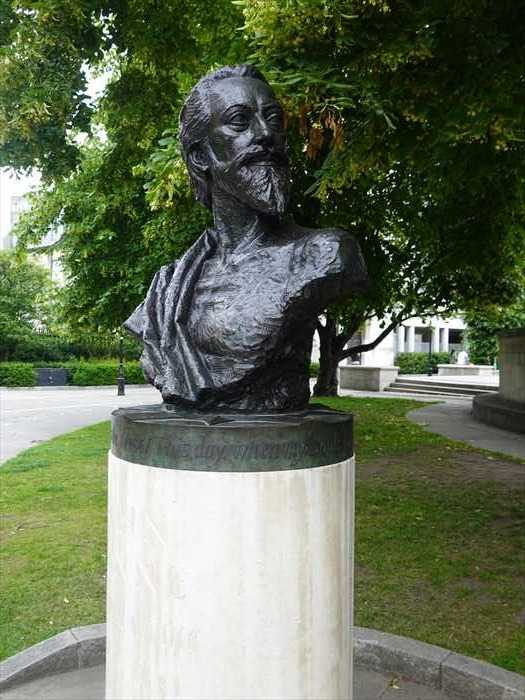
「 JOHN DONNE
【ジョン・ダン
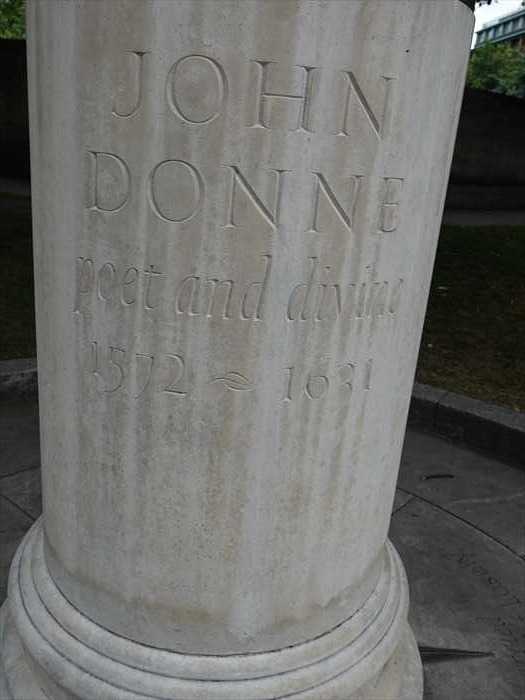
近づいて。
「 詩人であり聖職者であったジョン・ダン 」を顕彰しており、 彼の生没年(1572–1631) が
刻まれていた。

ロンドンの セント・ポール大聖堂(St Paul’s Cathedral) の特徴的な大ドーム も見納めか。
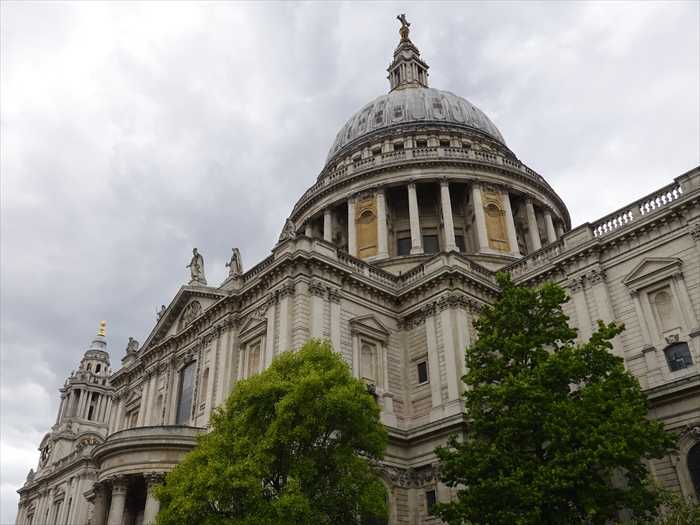
・当時のロンドンは産業革命の影響で人口が急増し、衛生や飲料水の確保が重要な社会問題と
なっていました。
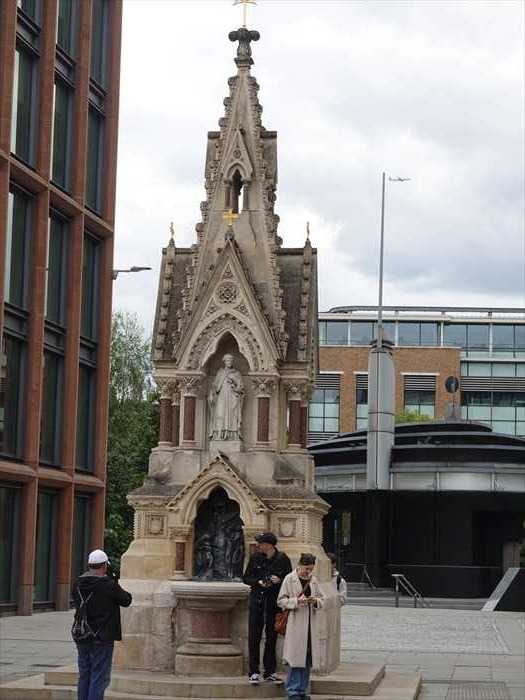
「 St Lawrence and Mary Magdalene Drinking Fountain 」は、
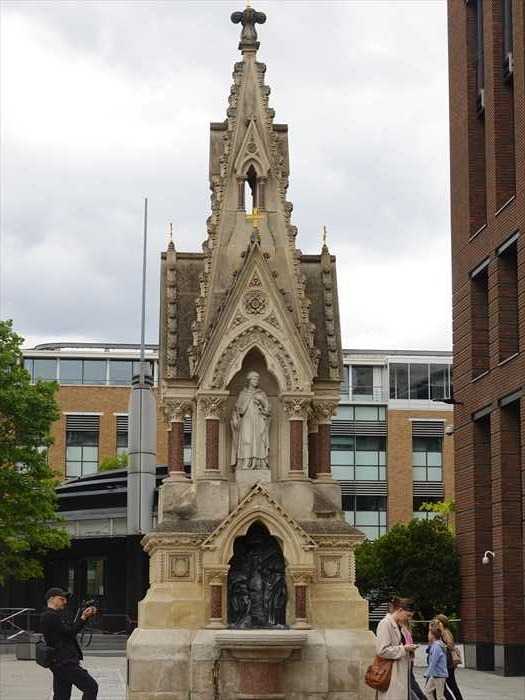
ブロンズのレリーフ(浮彫) に近づいて。

これでもかと。
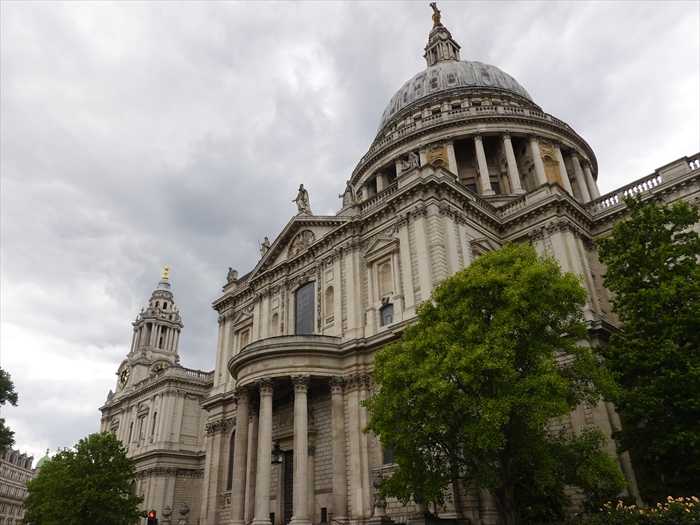
セント・ポール大聖堂(St Paul’s Cathedral) の西正面(West Front)を正面から。
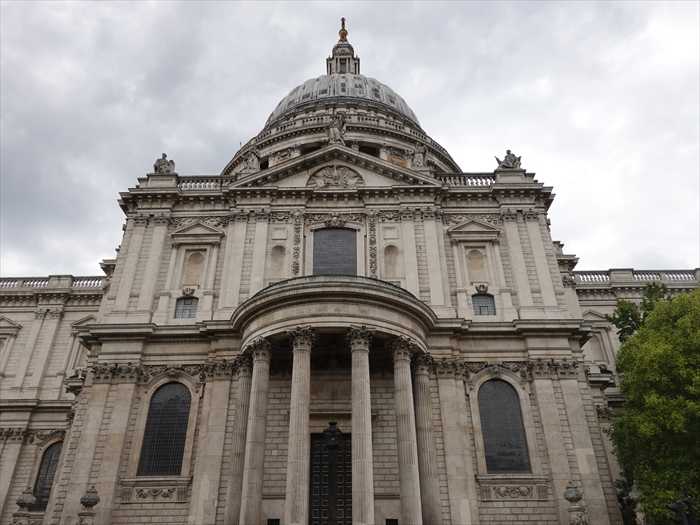
セント・ポール大聖堂の南側から テムズ川方向(ミレニアム・ブリッジ方面) を。
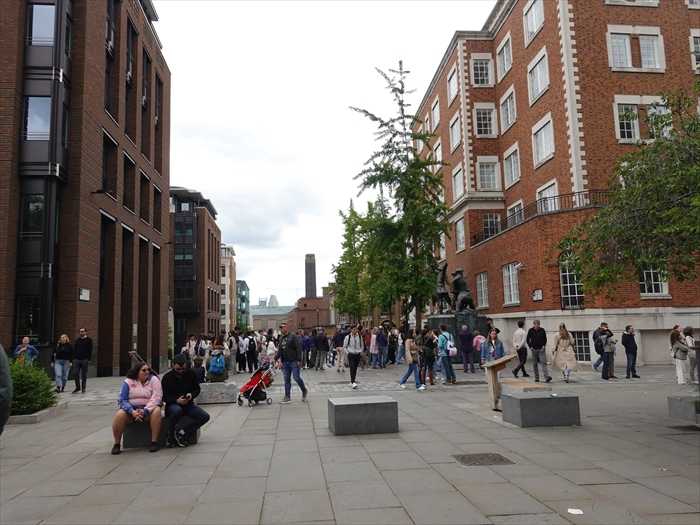
「 The National Firefighters Memorial(全国消防士記念碑) 」

・建立年: 1991年(当初は「Blitz Memorial」として第二次世界大戦の消防士を追悼)
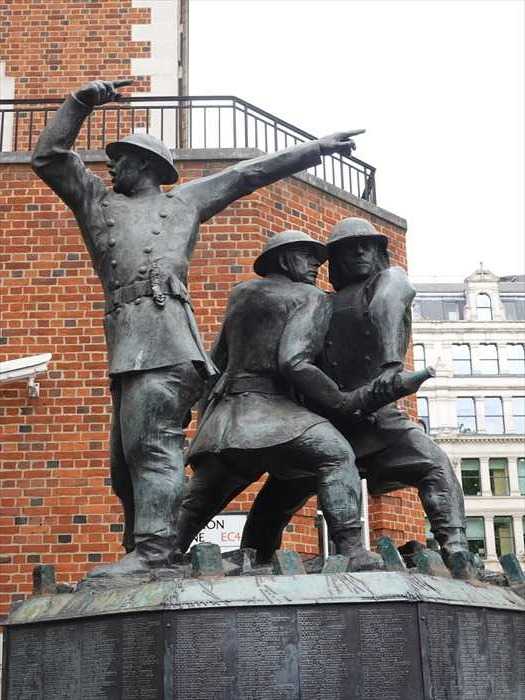
・右に見える高い黒い煙突
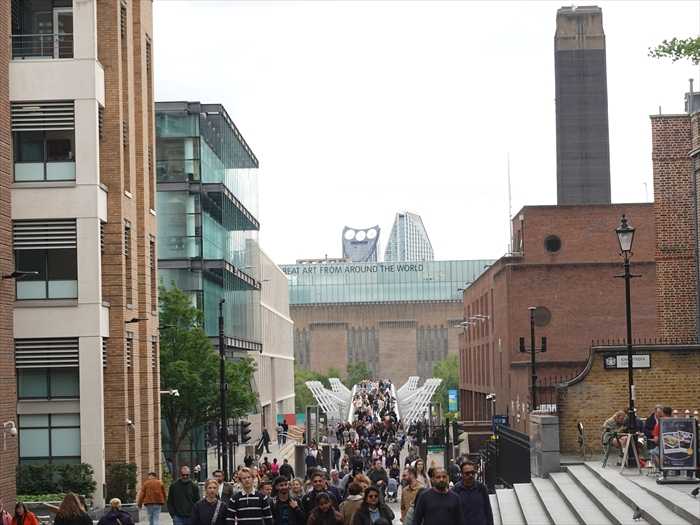
時間があったので、最後に再び 屋外特設展示コーナー へ。
この姿は、1170年にカンタベリー大聖堂で暗殺されたトマス・ベケット大司教が殉教する
瞬間を表しており、
・顔の歪み=苦しみと同時に信仰を貫く決意
・開かれた手=「神に委ねる」「無抵抗の殉教」 を象徴的に表していると考えられる と。

この胸像は ジョン・ダン(John Donne, 1572–1631) を表した記念像。
設置場所:
ロンドン、セント・ポール大聖堂前の庭園(セント・ポール大聖堂南側の敷地内)。
人物: ジョン・ダンはイングランドの著名な詩人であり、後に聖職者となって
セント・ポール大聖堂の首席司祭(Dean of St Paul’s) を務めた。
人物: ジョン・ダンはイングランドの著名な詩人であり、後に聖職者となって
セント・ポール大聖堂の首席司祭(Dean of St Paul’s) を務めた。
特徴:
鋭い眼差しと引き締まった頬、長い顎髭が力強く表現され、彼の精神性や知性を象徴。

「 JOHN DONNE
poet and divine
1572 – 1631」 【ジョン・ダン
詩人にして聖職者
1572年 – 1631年】
近づいて。
「 詩人であり聖職者であったジョン・ダン 」を顕彰しており、 彼の生没年(1572–1631) が
刻まれていた。

ロンドンの セント・ポール大聖堂(St Paul’s Cathedral) の特徴的な大ドーム も見納めか。

セント・ポール大聖堂(St Paul’s Cathedral)の北東側にあった
「 St Lawrence and Mary Magdalene Drinking Fountain
」。
1. 建設の目的
・この噴水は 19世紀のヴィクトリア朝時代(1866年) に設置されました。 ・当時のロンドンは産業革命の影響で人口が急増し、衛生や飲料水の確保が重要な社会問題と
なっていました。
・公共の「飲料水噴水(Drinking Fountain)」は、清潔な水を無料で市民に提供する目的で
設置されました。
設置されました。
2. 寄贈者
・この噴水は サムエル・ガーニー卿(Sir Samuel Gurney) の資金援助によるものです。
・ガーニー卿は慈善活動家であり、特に「公共飲料水運動」に深く関わっていました。
・彼は Metropolitan Drinking Fountain and Cattle Trough Association(MDFA) という
団体の支援者で、この団体はロンドン市内に多数の公共水飲み場を設置しました。
団体の支援者で、この団体はロンドン市内に多数の公共水飲み場を設置しました。
3. デザインと建築
・設計者は E. C. Robins(エドワード・チャールズ・ロビンス)。
・建築様式は ゴシック・リヴァイヴァル(Gothic Revival)。
・噴水の上部には 聖マグダラのマリア(Mary Magdalene)の像 が置かれています。
・この像の設置によって、噴水は「St Lawrence Jewry(隣接する教会)」と
「Mary Magdalene」の双方にちなんだ名称となりました。
「Mary Magdalene」の双方にちなんだ名称となりました。
4. 設置場所
・場所は セント・ポール大聖堂の北東側(Carter Lane と Cannon Street の交差付近)。
・隣接する St Lawrence Jewry 教会 が名前の一部となっている理由です。
・現在は周囲の近代建築の中に残されており、観光名所にもなっています。
5. その後の経緯
・当初は飲料水供給の役割を担っていましたが、現在は実際に水を供給していません。
・1970年代に修復が行われ、ロンドン市の歴史的モニュメントの一部として保存されています。
・英国指定建造物(Grade II listed building)に登録されており、文化財として保護
されています。
されています。

「 St Lawrence and Mary Magdalene Drinking Fountain 」は、
・1866年に慈善家サムエル・ガーニー卿の寄贈で建てられ、
・ロンドン市民に清潔な飲料水を提供する目的を持ち、
・ゴシック様式の美しい装飾と聖マグダラのマリア像を備えた公共水飲み場。

ブロンズのレリーフ(浮彫) に近づいて。
・左側には 母親と幼子が座り、幼子は母の腕に抱かれています。
・右側には 長い髪とひげの男性が立ち、杖(あるいは棒)で岩を指しています。
・背後には大きく割れた岩から水が流れ出ているように見えます。
これは旧約聖書の有名な場面で、モーセが荒野で岩を打ち、水を湧き出させた奇跡
(出エジプト記 17章、民数記 20章)を表現していると考えられます。
(出エジプト記 17章、民数記 20章)を表現していると考えられます。
イスラエルの民が荒野で渇き、モーセに訴えたとき、神の命によりモーセが杖で岩を打つと、
水が湧き出し、人々を潤しました と。
水が湧き出し、人々を潤しました と。

これでもかと。

セント・ポール大聖堂(St Paul’s Cathedral) の西正面(West Front)を正面から。

セント・ポール大聖堂の南側から テムズ川方向(ミレニアム・ブリッジ方面) を。
1.正面奥に見える高い煙突状の建物
・これは テート・モダン(Tate Modern) 美術館
。
・もともと「バンクサイド発電所」として1930年代に建設され、2000年に現代美術館へ改装
されました。
されました。
2.通りの雰囲気
・人々が集まっているのは「Peter’s Hill(ピーターズ・ヒル)」という遊歩道。
・ セント・ポール大聖堂とミレニアム・ブリッジを直線で結ぶために整備された歩行者専用ルート
。
3.右手の赤レンガの建物
・セント・ポール大聖堂の隣接建物群の一つで、オフィスや関連施設が入居しています。
・建物前に黒い銅像(腰を下ろす人物像)が見えたが、これは
「The National Firefighters Memorial(全国消防士記念碑)」。
「The National Firefighters Memorial(全国消防士記念碑)」。

「 The National Firefighters Memorial(全国消防士記念碑) 」
3体の消防士像が、瓦礫の中で消火・救助活動をする姿を表現。

・建立年: 1991年(当初は「Blitz Memorial」として第二次世界大戦の消防士を追悼)
・拡張:
2003年に「殉職したすべての消防士」を対象に改修され、正式に
「National Firefighters Memorial」と命名。
「National Firefighters Memorial」と命名。
・場所:
セント・ポール大聖堂南側、ミレニアム・ブリッジへ向かう Peter’s Hill の途中右側。
・デザイン:
彫刻家 John W. Mills による青銅像。
・3体の消防士像が、瓦礫の中で消火・救助活動をする姿を表現しています。
・背景:
特に1940年のロンドン大空襲(The Blitz)で殉職した多くの消防士を悼むために
建てられたもの。
建てられたもの。

・右に見える高い黒い煙突
→ Tate Modern の 旧発電所時代のシンボル的な煙突
。
・Tate Modern の後方に見えるガラス張りの三角屋根の高層ビル
→ サザークやサザーク・ブリッジ寄りの再開発地区の建物群

再び、 旧チャプター・ハウス跡
にあった 解説パネル。
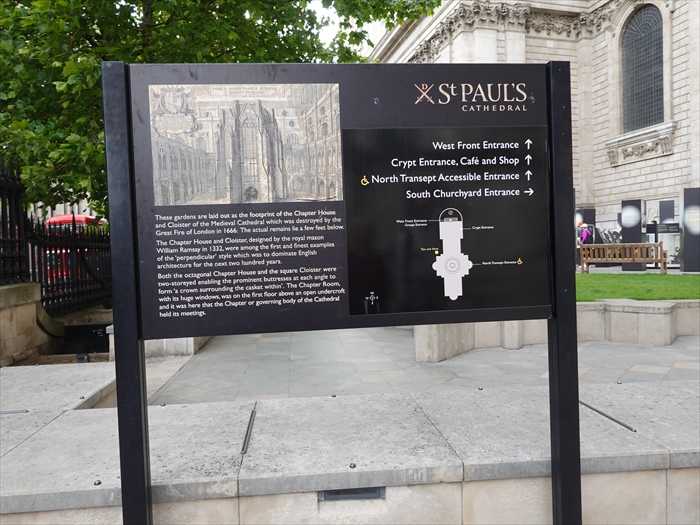
「These gardens are laid out in the footprint of the Chapter House

「These gardens are laid out in the footprint of the Chapter House
and Cloister of Old St Paul's Cathedral which was destroyed by the
Great Fire of London in 1666. The cloister was open on two sides.
The Chapter House and Cloister, designed by the royal architect
Inigo Jones in 1633, were regarded as the finest examples of
Renaissance architecture in London and in England.
Both the octagonal Chapter House and the square Cloister were
reconstructed following the medieval buildings on the same site.
It was here that meetings of the Cathedral's governing body,
the Dean and Chapter, were held. The Chapter House
was a large building with a central pillar supporting
its high vaulted roof.」
【この庭園は、旧セント・ポール大聖堂の
【この庭園は、旧セント・ポール大聖堂の
チャプター・ハウス(参事会堂)と
クロイスター(回廊)の跡地に整備されたものです。
旧大聖堂は 1666 年のロンドン大火で焼失しました。
クロイスターは二辺が開放されていました。
チャプター・ハウスとクロイスターは
王室建築家イニゴー・ジョーンズによって
1633 年に設計され、当時のロンドン、
そしてイングランドにおける
ルネサンス建築の最高傑作の一つと考えられていました。
八角形のチャプター・ハウス
四角形のクロイスターは
同じ場所にあった中世の建物を継承して再建されたものでした。
ここで大聖堂の運営組織である
ディーン(首席聖職者)とチャプター(参事会)の会合が開かれていました。
チャプター・ハウスは大きな建物で、
中央の柱が高いヴォールト天井を支えていました。】
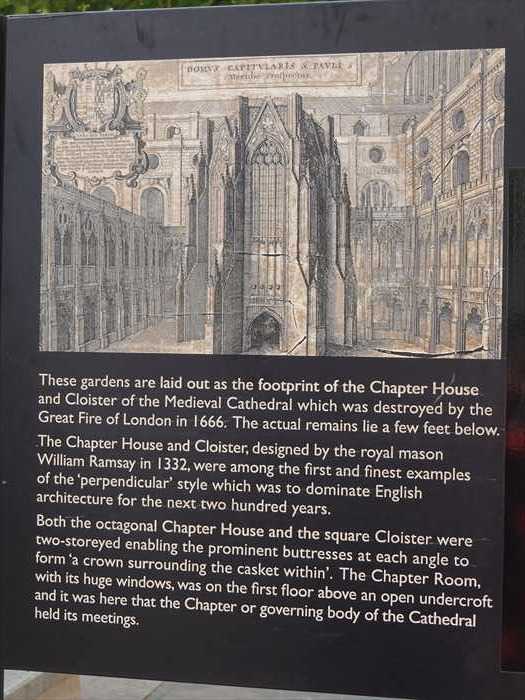
セント・ポール大聖堂の 旧クロイスター(回廊)とチャプターハウス(参事会会堂) を描いた
古い版画(挿絵)。 DOMUS CAPITULARIS S. PAULI・聖パウロ参事会会堂 と。


セント・ポール大聖堂の 旧クロイスター(回廊)とチャプターハウス(参事会会堂) を描いた
古い版画(挿絵)。 DOMUS CAPITULARIS S. PAULI・聖パウロ参事会会堂 と。

時間があったので、最後に再び 屋外特設展示コーナー へ。
セント・ポール大聖堂(St Paul’s Cathedral)西側
にあった 解説パネル
へ。


旧チャプター・ハウス跡の
展示会場。

「SAVING ST PAUL'S
展示テーマ
・中心テーマ:
第二次世界大戦(特に1940–41年のロンドン大空襲:The Blitz)におけるセント・ポール
大聖堂の役割と象徴性。
大聖堂の役割と象徴性。
・主要要素:
・ドームが煙の中に浮かび上がる有名な写真
・消火隊・市民ボランティアの活動
・「セント・ポールの守護者(St Paul’s Watch)」と呼ばれる防衛組織の記録
・戦火をくぐり抜けた聖堂が持つ精神的象徴としての意味

「SAVING ST PAUL'S
THE WATCH
AND THE SECOND WORLD WAR」
【セント・ポール大聖堂を守れ
【セント・ポール大聖堂を守れ
火消し隊(ザ・ウォッチ)
そして第二次世界大戦】
この展示は、第二次世界大戦中に空襲からセント・ポール大聖堂を守るために結成された
「 セント・ポールズ・ウォッチ(St Paul’s Watch) 」 という市民ボランティアの活動を
紹介していた。
「 セント・ポールズ・ウォッチ(St Paul’s Watch) 」 という市民ボランティアの活動を
紹介していた。
彼らは爆弾や焼夷弾が落下した際に、屋根裏やドーム上で消火や延焼防止にあたり、大聖堂を
戦火から救った。特に「ブリッツ(ロンドン大空襲)」の間、セント・ポールが瓦礫に埋もれず
立ち続けたことは、ロンドン市民にとって大きな精神的象徴になったのだと。
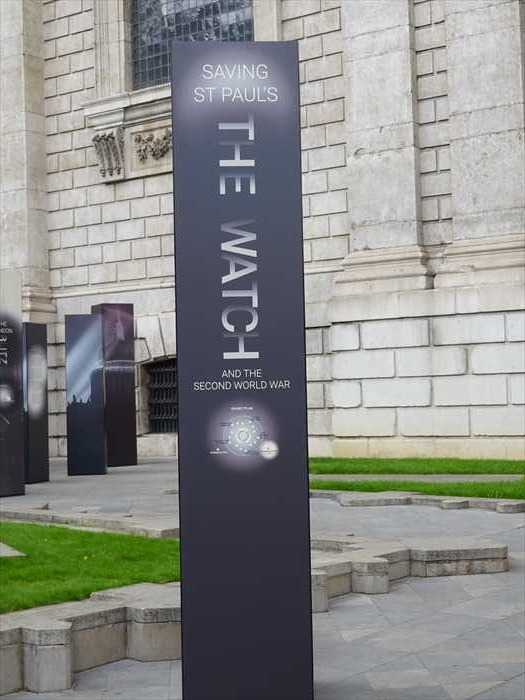
展示内容の案内図 。

この展示は、 第二次世界大戦中の ロンドン大空襲・
THE LONDON BLITZ
(1940–41)
に
おけるセント・ポール大聖堂の運命をテーマとしたものです。
特に、
・セント・ポールズ・ウォッチ(監視隊) の活躍、
・焼夷弾による被害と市民・消防隊による消火活動、
・爆撃後の瓦礫の中で奇跡的に残った大聖堂の姿、
・そして戦後の再建と象徴的役割 を段階的に紹介していた。
戦火から救った。特に「ブリッツ(ロンドン大空襲)」の間、セント・ポールが瓦礫に埋もれず
立ち続けたことは、ロンドン市民にとって大きな精神的象徴になったのだと。

「 INTRODUCTION
」
「NEW BEGINNINGS: THE FRIENDS OF ST PAUL’S
「NEW BEGINNINGS: THE FRIENDS OF ST PAUL’S
With the war over, the St Paul’s Watch was no longer needed. It was disbanded after
a farewell dinner in October 1945, when heartfelt toasts were made before the
members went their separate ways.
a farewell dinner in October 1945, when heartfelt toasts were made before the
members went their separate ways.
But this was not the end of the story. Life on the Watch had created such strong, lasting
ties of friendship and community, that some of its members decided to create a new
organisation: The Friends of St Paul’s Cathedral.
ties of friendship and community, that some of its members decided to create a new
organisation: The Friends of St Paul’s Cathedral.
Founded by Dean Matthews in 1952, the Friends raised funds for the restoration of the
Cathedral and promoted knowledge of its history and ongoing work. Some 83 members
attended the first meeting, but numbers grew rapidly.
Cathedral and promoted knowledge of its history and ongoing work. Some 83 members
attended the first meeting, but numbers grew rapidly.
The Friends are a unique community who come together to enjoy our music, heritage and spiritual learning – some even volunteer with us. Membership starts at £25 a year.
Find out more about joining the Friends by visiting stpauls.co.uk」
【 導入
新たな始まり:セント・ポール大聖堂の友の会
Find out more about joining the Friends by visiting stpauls.co.uk」
【 導入
新たな始まり:セント・ポール大聖堂の友の会
戦争が終わり、「セント・ポール監視隊(St Paul’s Watch)」はもはや必要とされなく
なりました。1945年10月の送別会をもって解散し、心からの乾杯の後、隊員たちは
それぞれの道へと散っていきました。
なりました。1945年10月の送別会をもって解散し、心からの乾杯の後、隊員たちは
それぞれの道へと散っていきました。
しかし、これで物語は終わりではありませんでした。監視隊での生活によって強く永続的な
友情と共同体意識が育まれたため、その一部の隊員たちは新たな組織「セント・ポール
大聖堂の友の会(The Friends of St Paul’s Cathedral)」を設立することを決意したのです。
友情と共同体意識が育まれたため、その一部の隊員たちは新たな組織「セント・ポール
大聖堂の友の会(The Friends of St Paul’s Cathedral)」を設立することを決意したのです。
1952年にマシューズ学長によって設立された友の会は、大聖堂の修復のための資金を集め、
その歴史や継続的な活動についての知識を広めました。最初の会合には83人が参加しましたが、
その後会員数は急速に増加しました。
その歴史や継続的な活動についての知識を広めました。最初の会合には83人が参加しましたが、
その後会員数は急速に増加しました。
友の会は独自の共同体であり、音楽、遺産、そして霊的な学びを楽しむために集います。
一部の人々はボランティアとして活動にも参加しています。会員費は年間25ポンドから。
詳細は stpauls.co.uk をご覧ください。】
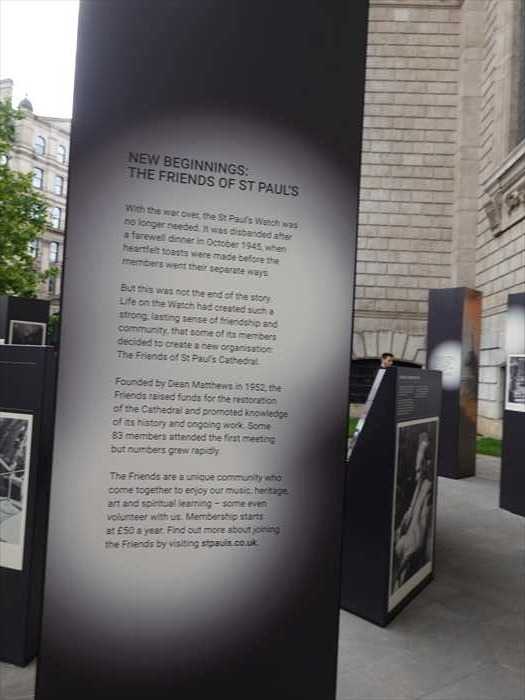
INTRODUCTION
一部の人々はボランティアとして活動にも参加しています。会員費は年間25ポンドから。
詳細は stpauls.co.uk をご覧ください。】

INTRODUCTION
この展示は、セント・ポール大聖堂の防衛活動(St Paul’s Watch)から、戦後の追悼と国際的な
記念の場の創出へと続く流れを示しているもの。
「 IN REMEMBRANCE
記念の場の創出へと続く流れを示しているもの。
「 IN REMEMBRANCE
The aftermath of the war held many challenges: reconstruction, more food rationing,
and reintegration for those returning after five long years away. Time was needed too,
for mourning the missing, and the dead.
and reintegration for those returning after five long years away. Time was needed too,
for mourning the missing, and the dead.
The St Paul’s Watch was commemorated with a dedication on a flagstone inside
the Cathedral. In 1946, a fund was set up to build the American Memorial Chapel,
in tribute to the 28,000 American servicemen and women who lost their lives during
the Second World War while stationed in Britain.
the Cathedral. In 1946, a fund was set up to build the American Memorial Chapel,
in tribute to the 28,000 American servicemen and women who lost their lives during
the Second World War while stationed in Britain.
Watch Commander Godfrey Allen was one of the architects who designed the Chapel.
It was located in the Apse, which was reconstructed after sustaining bomb damage
during the war. The American Memorial Chapel was dedicated in November 1958
with a service attended by the Royal Family.」
【 追悼
戦争が終わった後、人々は多くの課題に直面しました。復興、食料配給の継続、そして5年に及ぶ
It was located in the Apse, which was reconstructed after sustaining bomb damage
during the war. The American Memorial Chapel was dedicated in November 1958
with a service attended by the Royal Family.」
【 追悼
戦争が終わった後、人々は多くの課題に直面しました。復興、食料配給の継続、そして5年に及ぶ
長い年月を経て帰還した人々の社会復帰です。また、行方不明者や戦死者を悼む時間も必要でした。
セント・ポールの監視団(St Paul’s Watch)は、大聖堂内部の石畳への献辞によって
記念されました。1946年には、アメリカ記念礼拝堂(American Memorial Chapel) 建設の
ための基金が設立されました。これは第二次世界大戦中、イギリスに駐留し戦死した
記念されました。1946年には、アメリカ記念礼拝堂(American Memorial Chapel) 建設の
ための基金が設立されました。これは第二次世界大戦中、イギリスに駐留し戦死した
28,000人のアメリカ兵士たち に捧げられたものです。
礼拝堂の設計者のひとりは監視団の指揮官 ゴドフリー・アレン(Godfrey Allen) でした。
礼拝堂は戦争中に爆撃被害を受けた内陣(アプス)に設けられ、修復の一環として
再建されました。
再建されました。
アメリカ記念礼拝堂は1958年11月に献堂式が行われ、王室の参列を受けました。】
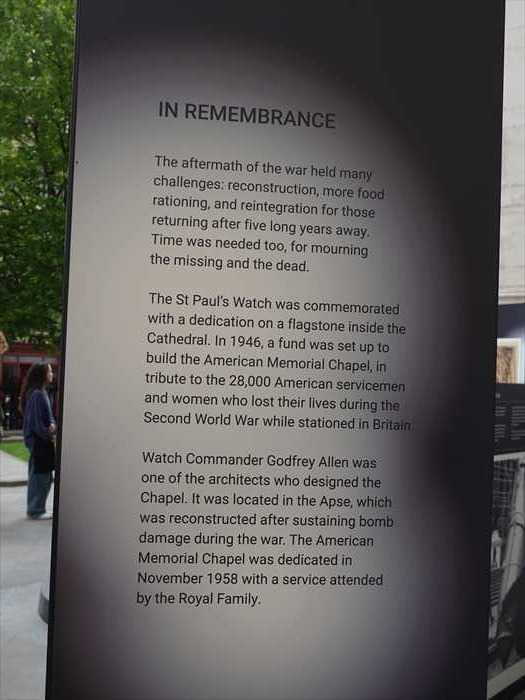

展示内容の案内図 。
1. 導入(INTRODUCTION)
・目的:展示のテーマを説明し、訪問者を「戦中のセント・ポール」の世界へ導く。
・内容:大聖堂が第二次世界大戦中に直面した脅威の概要。
2. ロンドン大空襲(THE LONDON BLITZ)
・焦点:1940~41年のロンドン大空襲。
・展示内容:
・有名な「煙の中に浮かぶドーム」の写真。
・市街地の破壊と人々の恐怖。
3. 戦中の危険と被害(DANGER & DAMAGE)
・焦点:セント・ポールを襲った爆撃の実態。
・展示内容:
・爆弾による損傷の痕跡。
・焼夷弾が屋根に落ちた記録。
・爆破の危機から奇跡的に守られた出来事。
4. セント・ポールの防衛(PROTECTING ST PAUL’S)
・焦点:「St Paul’s Watch」と呼ばれた市民防衛隊。
・展示内容:
・消火活動の様子(屋根での水バケツリレー)。
・ボランティア市民の奮闘。
・当時の記録写真や証言。
5. 見張りの生活(LIFE ON THE WATCH)
・焦点:大聖堂を守る人々の日常。
・展示内容:
・夜通し続いた待機と緊張感。
・防空壕や仮眠の様子。
・彼らが残した日記やメモ。
6. 戦後(AFTER THE WAR)
・焦点:戦後復興と大聖堂の象徴的意味。
・展示内容:
・国民に希望を与えた「セント・ポールの不屈のドーム」。
・戦争終結後の追悼と記憶の継承。
7. 中央ゾーン(PEOPLE STORIES)
・テーマ:「人々の物語」
・内容:実際にセント・ポールを守った人々の証言、体験談、名前。
・役割:外周展示を人間的な視点で結びつける中心要素。

おけるセント・ポール大聖堂の運命をテーマとしたものです。
特に、
・セント・ポールズ・ウォッチ(監視隊) の活躍、
・焼夷弾による被害と市民・消防隊による消火活動、
・爆撃後の瓦礫の中で奇跡的に残った大聖堂の姿、
・そして戦後の再建と象徴的役割 を段階的に紹介していた。

展示の「 THE LONDON BLITZ(ロンドン大空襲)
」 セクションで最も有名な場面のひとつ。
・大聖堂のドームが煙の中に浮かび上がっている。
・これは 1940年12月29日夜、ロンドン大空襲(Blitz)の最も激しい日
「Second Great Fire of London(二度目のロンドン大火)」の記録。
「This iconic photograph was taken by Herbert Mason at the height of the London Blitz,
on 30th December 1940. It immediately became an enduring symbol of Britain’s
wartime bravery and resilience.
「Second Great Fire of London(二度目のロンドン大火)」の記録。
「This iconic photograph was taken by Herbert Mason at the height of the London Blitz,
on 30th December 1940. It immediately became an enduring symbol of Britain’s
wartime bravery and resilience.
In Nazi Germany, the same image was used as propaganda to convince the population
that St Paul’s had been destroyed — false evidence that the Luftwaffe’s bombing raids
were a success.」
【この象徴的な写真は、1940年12月30日、ロンドン大空襲の最中にハーバート・メイソンに
よって撮影された。写真は瞬く間に、イギリスの戦時下における勇気と不屈の象徴となった。
that St Paul’s had been destroyed — false evidence that the Luftwaffe’s bombing raids
were a success.」
【この象徴的な写真は、1940年12月30日、ロンドン大空襲の最中にハーバート・メイソンに
よって撮影された。写真は瞬く間に、イギリスの戦時下における勇気と不屈の象徴となった。
一方、ナチス・ドイツでは同じ写真がプロパガンダとして利用され、セント・ポールが破壊された
かのように市民に信じ込ませる偽の証拠として使われた。】
かのように市民に信じ込ませる偽の証拠として使われた。】

このパネルは「 THE LONDON BLITZ IN NUMBERS(数字で見るロンドン大空襲) 」 を
テーマとする統計的な展示解説。
「 THE LONDON BLITZ IN NUMBERS
1 million
Houses and flats damaged or destroyed in London. One in every six Londoners was made homeless at some point during the Blitz.
180,000
People per night sheltered in the London Underground system during the Blitz.
100,000
Incendiary bombs plus 24,000 high explosive bombs were dropped on London in
just one night, between 6pm on December 1940 and the early hours of the next morning.
just one night, between 6pm on December 1940 and the early hours of the next morning.
43,500
Civilians killed during the first eight months of attacks, with nearly half of Britain’s
total civilian deaths for the whole war occurring during the Blitz.
total civilian deaths for the whole war occurring during the Blitz.
2,136
Estimated number of fires recorded by the London Fire Brigade.」
【 数字で見るロンドン大空襲
【 数字で見るロンドン大空襲
100万
ロンドンで損壊または破壊された住宅の数。空襲の間に、ロンドン市民6人に1人が住む家を失った。
18万
ロンドン地下鉄に毎晩避難した人々の数。
10万
焼夷弾に加え、24,000発の高性能爆弾が、1940年12月のある夜18時から翌朝早くまでの一晩で
ロンドンに投下された。
ロンドンに投下された。
43,500
最初の8か月間の空襲で死亡した民間人の数。これは戦争全体におけるイギリス民間人死者数の
ほぼ半数に相当する。
ほぼ半数に相当する。
2,136
ロンドン消防隊が記録した推定火災件数。】
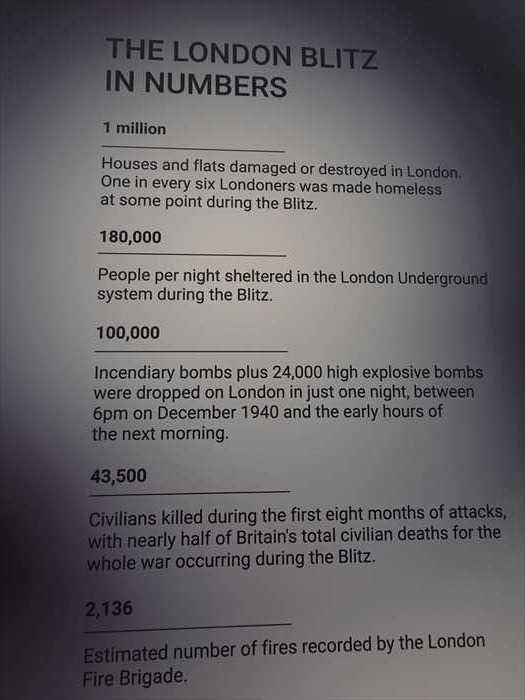
「350

「350
September and November 1940.
88
German aircraft were shot down over London, and 22 RAF planes were lost,
according to Air Ministry reports.
according to Air Ministry reports.
57
Nights of consecutive bombing, from 7th September 1940.」
【350
【350
1940年9月から11月のブリッツ最盛期における空襲警報の回数。
88
空襲中にロンドン上空で撃墜されたドイツ軍機の数。一方で、RAF(英国空軍)の戦闘機22機が
失われた(英国航空省の報告による)。
失われた(英国航空省の報告による)。
57
1940年9月7日から続いた、連続爆撃の日数。】

「 GERMANY’S WEAPONS OF WAR(ドイツの戦争兵器) 」 を解説する展示
「 GERMANY’S WEAPONS OF WAR

「 GERMANY’S WEAPONS OF WAR(ドイツの戦争兵器) 」 を解説する展示
「 GERMANY’S WEAPONS OF WAR
The Luftwaffe employed a variety of weapons and tactics to target London and
other British cities.
other British cities.
Lightweight incendiary bombs were widely used to start fires that could spread to
neighbouring buildings. Mines and larger high-explosive bombs were dropped to
maximise damage.
neighbouring buildings. Mines and larger high-explosive bombs were dropped to
maximise damage.
By 1944, among the most deadly threats were the ‘doodlebug’ V1 and V2 high-speed
missiles. ‘V’ was short for Vergeltungswaffe, meaning ‘vengeance weapon’. These lethal
rockets were made by prisoners in Nazi concentration camps. Conditions there were
so appalling that more people died making the rockets than those killed by them
in air raids. More than 500 V2 rockets were used in attacks on London.」
【ドイツの戦争兵器ルフトヴァッフェ(ドイツ空軍)は、ロンドンや他の英国都市を攻撃する
ためにさまざまな兵器と戦術を用いた。
missiles. ‘V’ was short for Vergeltungswaffe, meaning ‘vengeance weapon’. These lethal
rockets were made by prisoners in Nazi concentration camps. Conditions there were
so appalling that more people died making the rockets than those killed by them
in air raids. More than 500 V2 rockets were used in attacks on London.」
【ドイツの戦争兵器ルフトヴァッフェ(ドイツ空軍)は、ロンドンや他の英国都市を攻撃する
ためにさまざまな兵器と戦術を用いた。
軽量の焼夷弾は広く使用され、隣接する建物へと火災を拡大させた。さらに、地雷や大型の
高性能爆弾が投下され、被害を最大化した。
1944年までには、最も致命的な脅威の一つが「ドゥードルバグ(ブンブン虫)」と呼ばれた
V1およびV2高速ミサイルであった。「V」とはドイツ語・Vergeltungswaffe(報復兵器)の略で
ある。これらの致死的なロケットは、ナチスの強制収容所で囚人によって製造された。
劣悪な環境は恐るべきもので、空襲でロケットに殺された人々よりも、多くの人々が製造過程で
命を落とした。ロンドンへの攻撃には500発以上のV2ロケットが使用された。】
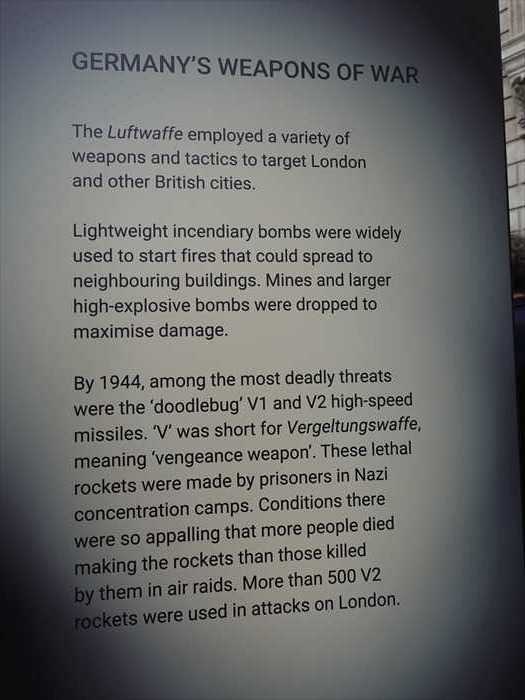
「 THE LONDON BLITZ(ロンドン大空襲) 」
「 THE LONDON BLITZ
V1およびV2高速ミサイルであった。「V」とはドイツ語・Vergeltungswaffe(報復兵器)の略で
ある。これらの致死的なロケットは、ナチスの強制収容所で囚人によって製造された。
劣悪な環境は恐るべきもので、空襲でロケットに殺された人々よりも、多くの人々が製造過程で
命を落とした。ロンドンへの攻撃には500発以上のV2ロケットが使用された。】

「 THE LONDON BLITZ(ロンドン大空襲) 」
「 THE LONDON BLITZ
Firemen battle a burning office block on Ludgate Hill, with St Paul’s visible
in the background.」
【 ロンドン大空襲
in the background.」
【 ロンドン大空襲
ルドゲート・ヒル(St Paul’s大聖堂の前の通り)で、炎上するオフィスビルと格闘する
消防士たち。背景にはセント・ポール大聖堂が見える。】

この写真パネルも 「 THE LONDON BLITZ(ロンドン大空襲) 」 の展示の一部。
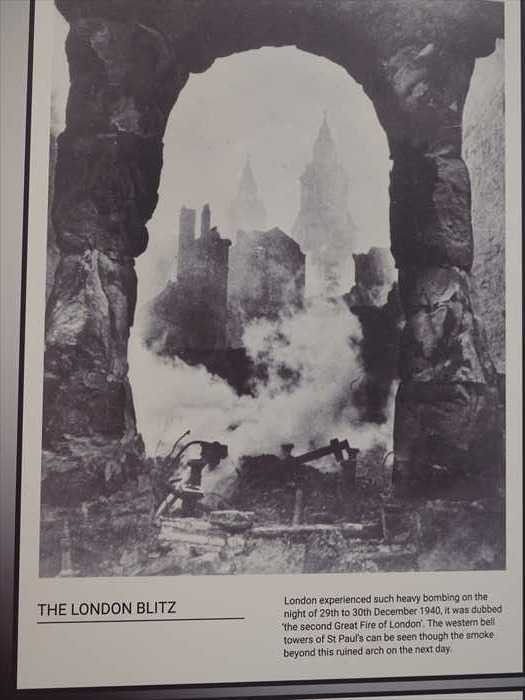
セント・ポール大聖堂のドームを背景に立つ女性たち を捉えた戦時中のスナップ。
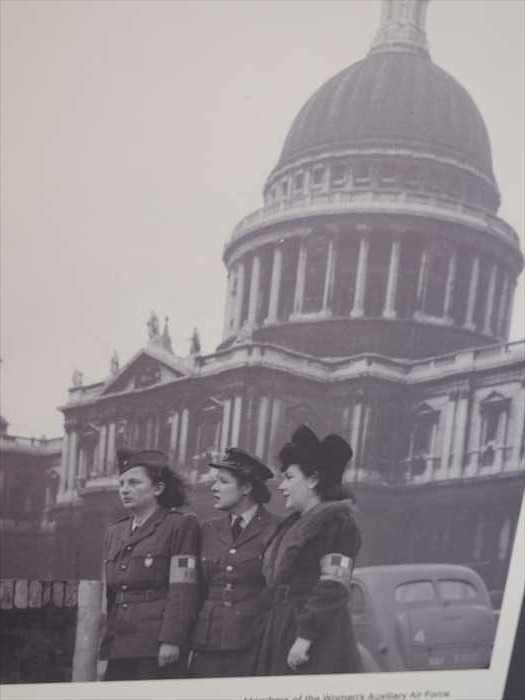
消防士たち。背景にはセント・ポール大聖堂が見える。】

この写真パネルも 「 THE LONDON BLITZ(ロンドン大空襲) 」 の展示の一部。
日付:
1940年12月29日~30日の夜 → 「ロンドンの第二の大火
(The Second Great Fire of London)」と呼ばれるほどの大規模空襲。
(The Second Great Fire of London)」と呼ばれるほどの大規模空襲。
視点:
焼け落ちたアーチの向こうに煙に包まれた大聖堂の塔が浮かび上がり、破壊と希望の
コントラストを表現している。
「 THE LONDON BLITZ
コントラストを表現している。
「 THE LONDON BLITZ
London experienced such heavy bombing on the night of 29th to 30th December 1940,
it was dubbed "the second Great Fire of London". The western bell towers of St Paul’s
can be seen through the smoke beyond this ruined arch on the next day.」
【 ロンドン大空襲
it was dubbed "the second Great Fire of London". The western bell towers of St Paul’s
can be seen through the smoke beyond this ruined arch on the next day.」
【 ロンドン大空襲
1940年12月29日から30日にかけて、ロンドンは激しい爆撃を受け、それは
「ロンドンの第二の大火」と呼ばれた。
「ロンドンの第二の大火」と呼ばれた。
写真は翌日、瓦礫と化したアーチ越しに、煙の向こうに見えるセント・ポール大聖堂の
西の鐘塔を写したものである。】
西の鐘塔を写したものである。】

セント・ポール大聖堂のドームを背景に立つ女性たち を捉えた戦時中のスナップ。
前景:
3人の女性
・左の2人は制服姿(女性補助空軍 WAAF や、女性防衛隊員の可能性あり)
・右の女性は市民服だが腕章を付けており、戦時における支援活動を担っていたことを示唆。
背景:
セント・ポール大聖堂の大ドームがはっきり写っている。大聖堂は、ロンドン大空襲中の
精神的支柱・国民の象徴であった。
精神的支柱・国民の象徴であった。

「 DANGER AND DAMAGE(危険と被害) 」
大聖堂が戦時中に直面した被害をテーマにした展示 。
・背景写真
・パネルの背景には、爆撃後の修復作業か、建物内部の補強工事の様子と思われる白黒写真
が使用されていた。
・焼夷弾や爆撃で破壊された部分を補強する足場が描かれていた。
・「戦時中にセント・ポールが受けた具体的な被害」を紹介

「‘None of us will, I imagine, forget the dull roar of those tons of falling masonry
followed by the rasping sound of falling glass which seemed to continue for
many minutes.’
Watch Commander Godfrey Allen, recalling the night of 16th April 1941」
【「我々の誰一人として忘れることはないだろう。何トンもの石材が崩れ落ちる鈍い轟音、
その後に続いたガラスが砕け散る鋭い音――それは何分もの間、鳴り響き続けていた。」
見張り隊指揮官 ゴドフリー・アレン、1941年4月16日の夜を回想して】

「 RECRUITMENT AND EXPANSION
By 1940 the Cathedral urgently needed to increase its number of volunteers on the
Watch, and the initial group of around 40 soon grew to 84 people, allowing for
12 men to work each shift.
Watch, and the initial group of around 40 soon grew to 84 people, allowing for
12 men to work each shift.
An appeal to the Royal Institute of British Architects (RIBA) included in its job description
‘Men from 40 to 60 who can walk upstairs and not fear heights’.
‘Men from 40 to 60 who can walk upstairs and not fear heights’.
The number of volunteers on the Watch grew to more than 300 people as the war
advanced. Men and women came from various backgrounds, bravely placing themselves
in harm's way to protect the Cathedral. Together, they forged a great sense of camaraderie during a time of crisis.」
【 募集と拡大
advanced. Men and women came from various backgrounds, bravely placing themselves
in harm's way to protect the Cathedral. Together, they forged a great sense of camaraderie during a time of crisis.」
【 募集と拡大
1940年までに、大聖堂は「見張り隊(Watch)」のボランティアを急いで増やす必要があった。
最初は約40名で構成されていた隊は、すぐに84名に拡大し、各シフトに12人を配置できる
ようになった。
最初は約40名で構成されていた隊は、すぐに84名に拡大し、各シフトに12人を配置できる
ようになった。
英国王立建築家協会(RIBA)が出した募集要項にはこう書かれていた:
「40歳から60歳までの、階段を上れること、高所を恐れない男性」。
戦争が進むにつれ、見張り隊の人数は300名以上にまで膨れ上がった。男性も女性も、さまざまな
背景から集まり、大聖堂を守るために危険を顧みず行動した。彼らはこの危機の時代に、
強い仲間意識を育んでいった。】
背景から集まり、大聖堂を守るために危険を顧みず行動した。彼らはこの危機の時代に、
強い仲間意識を育んでいった。】

「 A DIRECT HIT
‘Report very bad night, everyone behaved splendidly’
This report was written by J. Green in the St Paul’s Watch logbook, on 16th April 1941.
It is a typically understated account of what must have been a terrifying,
life threatening experience for members of the Watch.
It is a typically understated account of what must have been a terrifying,
life threatening experience for members of the Watch.
On that occasion, the Cathedral suffered significant damage from a bomb that
hit the North Transept. This was just one of many perilous incidents that the Watch had
to cope with. During another heavy air raid on London, fires raged on every side of the
Cathedral after it was struck by 28 incendiary bombs.
hit the North Transept. This was just one of many perilous incidents that the Watch had
to cope with. During another heavy air raid on London, fires raged on every side of the
Cathedral after it was struck by 28 incendiary bombs.
Incredibly, not a single member of the Watch lost their lives during wartime service.」
【 直撃
【 直撃
「非常にひどい夜だったが、皆立派に振る舞った」
この記録は1941年4月16日、J・グリーンによってセント・ポールズ・ウォッチの日誌に書かれた
ものである。恐ろしいほどの、命を脅かす体験だったに違いない出来事を、典型的な英国流の
控えめな筆致で記したものである。
ものである。恐ろしいほどの、命を脅かす体験だったに違いない出来事を、典型的な英国流の
控えめな筆致で記したものである。
その夜、大聖堂は北翼廊を直撃した爆弾によって深刻な被害を受けた。これはウォッチが対処
せねばならなかった数多くの危険な出来事の一つに過ぎなかった。別の大規模なロンドン空襲では、
大聖堂の周囲の至る所で火災が燃え広がり、焼夷弾28発の直撃を受けた。
せねばならなかった数多くの危険な出来事の一つに過ぎなかった。別の大規模なロンドン空襲では、
大聖堂の周囲の至る所で火災が燃え広がり、焼夷弾28発の直撃を受けた。
驚くべきことに、戦時中、ウォッチのメンバーで命を落とした者は一人もいなかった。】
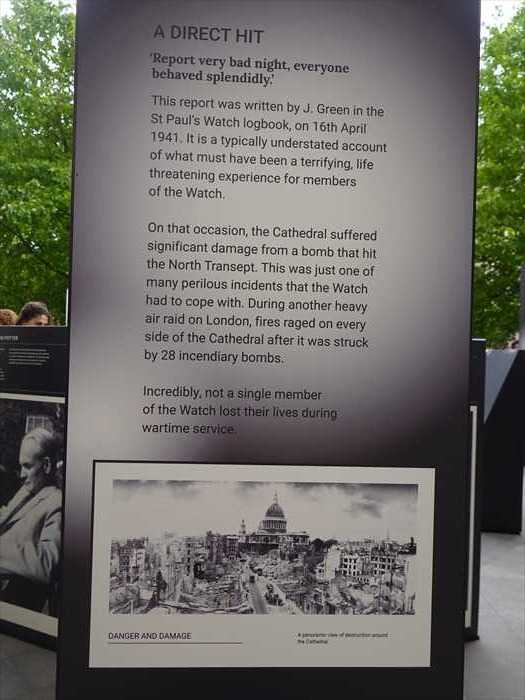
「 DANGER AND DAMAGE

「 DANGER AND DAMAGE
A panoramic view of destruction around the Cathedral.」
【 危険と被害
【 危険と被害
大聖堂周辺の破壊のパノラマビュー。】
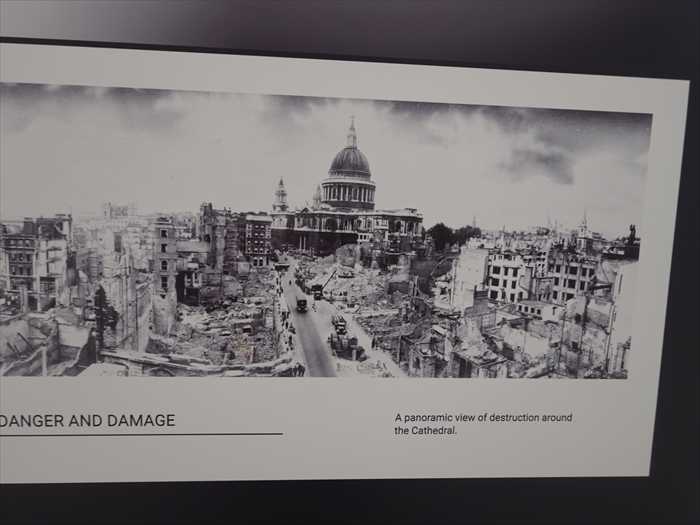
ネットから。

「 DANGER AND DAMAGE

ネットから。
この写真は第二次世界大戦中のロンドン大空襲(ブリッツ)後に撮影されたもので、
セント・ポール大聖堂を中心に、周囲の街区が壊滅的な爆撃被害を受けた様子を示している。
セント・ポール大聖堂を中心に、周囲の街区が壊滅的な爆撃被害を受けた様子を示している。
興味深いのは、周囲が瓦礫と廃墟に覆われながらも、大聖堂自体は奇跡的に大きく崩壊せず
残ったこと。これが当時「St Paul’s Survives(セント・ポールは生き残った)」という
象徴的な写真とともに、市民に大きな希望を与えたのだと。
残ったこと。これが当時「St Paul’s Survives(セント・ポールは生き残った)」という
象徴的な写真とともに、市民に大きな希望を与えたのだと。

「 DANGER AND DAMAGE
Amid the rubble, a member of the clergy inspects two cherub figurines that survived the bombing.
The cherubs pose as if they are raising their arms over their heads for protection.」
【 危険と被害
瓦礫の中で、聖職者が爆撃を生き延びた二体のケルブ像を調べている。
ケルブたちは、まるで頭上に腕を掲げて身を守っているかのような姿勢をとっている。】
ブリッツで被害を受けたセント・ポール大聖堂内部の様子を示している。
瓦礫に覆われた中でなお残ったケルブ像は、壊滅的な破壊の中にあって「奇跡的な生還」や
「信仰の守護」を象徴するものとして強く印象づけられたのであった。

「 DANGER AND DAMAGE
ブリッツで被害を受けたセント・ポール大聖堂内部の様子を示している。
瓦礫に覆われた中でなお残ったケルブ像は、壊滅的な破壊の中にあって「奇跡的な生還」や
「信仰の守護」を象徴するものとして強く印象づけられたのであった。

「 DANGER AND DAMAGE
Bomb damage in the North Transept. The explosion blew a hole in the roof and
the floor below, and falling masonry landed in the Crypt.」
【 危険と被害
the floor below, and falling masonry landed in the Crypt.」
【 危険と被害
北翼廊の爆撃被害。爆発によって屋根とその下の床に大きな穴が開き、落下した石材が
地下納骨堂にまで達した。】
この写真は、第二次世界大戦中の空襲(ブリッツ)でセント・ポール大聖堂が受けた深刻な被害を
示している。特に北翼廊の屋根から床を貫通して地下のクリプト(地下礼拝堂・納骨所)にまで
崩落した様子は、建物の存続を危うくしたことがわかるのであった。
地下納骨堂にまで達した。】
この写真は、第二次世界大戦中の空襲(ブリッツ)でセント・ポール大聖堂が受けた深刻な被害を
示している。特に北翼廊の屋根から床を貫通して地下のクリプト(地下礼拝堂・納骨所)にまで
崩落した様子は、建物の存続を危うくしたことがわかるのであった。

「 SECONDS FROM DISASTER
During the bombing raids of 16th to 17th April 1941, a German naval mine was
dropped in the North East Churchyard. It was discovered by the Cathedral’s
Sub-Librarian Gerald Henderson, who spotted an object covered in green parachute silk.
dropped in the North East Churchyard. It was discovered by the Cathedral’s
Sub-Librarian Gerald Henderson, who spotted an object covered in green parachute silk.
A naval mine disposal expert was hurriedly called in. Lieutenant Ronald James Smith had
to crawl underneath the mine to make it safe. As he began to unscrew the fuse,
vibrations from a passing fire engine moved the mine and it began ticking.
to crawl underneath the mine to make it safe. As he began to unscrew the fuse,
vibrations from a passing fire engine moved the mine and it began ticking.
Smith had around 17 seconds before it exploded. With nerves of steel, he deactivated
the mine with just two seconds to spare, saving himself, the Cathedral and all those inside.」
【 大惨事まであと数秒
the mine with just two seconds to spare, saving himself, the Cathedral and all those inside.」
【 大惨事まであと数秒
1941年4月16日から17日の空襲の際、ドイツ海軍の機雷が北東の墓地に投下された。
大聖堂の副司書ジェラルド・ヘンダーソンが、緑色のパラシュート絹に覆われた物体を発見した。
大聖堂の副司書ジェラルド・ヘンダーソンが、緑色のパラシュート絹に覆われた物体を発見した。
急いで海軍の機雷処理専門家が呼ばれた。ロナルド・ジェームズ・スミス中尉は、安全化のために
機雷の下にもぐり込まねばならなかった。信管を外し始めたとき、通り過ぎる消防車の振動で
機雷が動き、時限装置が作動し始めた。
機雷の下にもぐり込まねばならなかった。信管を外し始めたとき、通り過ぎる消防車の振動で
機雷が動き、時限装置が作動し始めた。
スミスには爆発までおよそ17秒しか残されていなかった。しかし彼は鋼のような神経で処理を
進め、残りわずか2秒というところで機雷を解除することに成功し、自らと大聖堂、そして
中にいた人々を救った。】
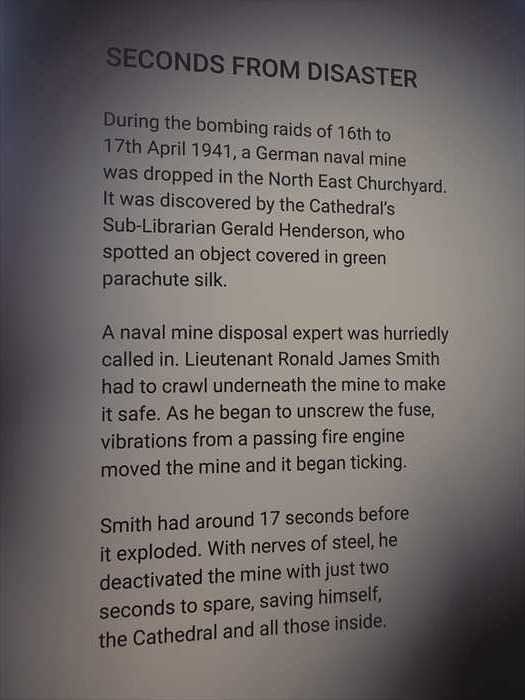
「 DANGER AND DAMAGE
進め、残りわずか2秒というところで機雷を解除することに成功し、自らと大聖堂、そして
中にいた人々を救った。】

「 DANGER AND DAMAGE
Bomb debris and rubble are scattered across the floor by the Cathedral’s High Altar.
If you look to the left of the photograph, you can see a tall candlestick.」
【 危険と被害
If you look to the left of the photograph, you can see a tall candlestick.」
【 危険と被害
お気に入りの記事を「いいね!」で応援しよう
【毎日開催】
15記事にいいね!で1ポイント
10秒滞在
いいね!
--
/
--
© Rakuten Group, Inc.












